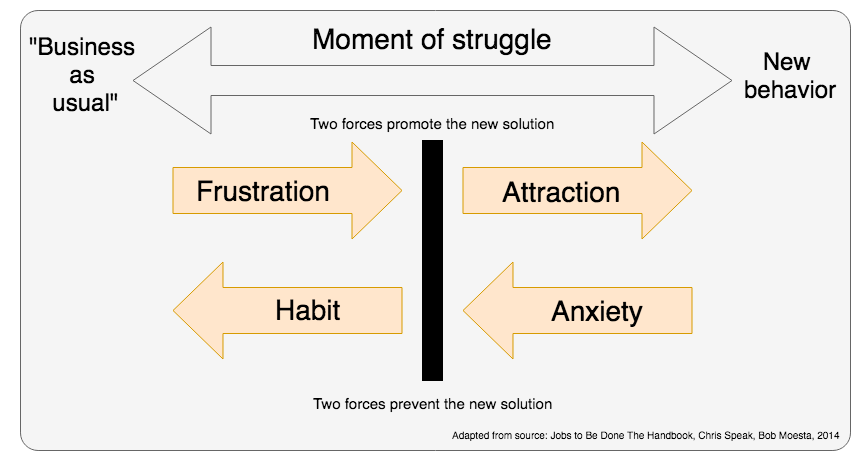Who or what is my competition? Which product categories am I competing against? Could my own customer even be a potential competitor for the “job” at hand? These are just a few of the questions we should ask ourselves to accurately assess of competitive conditions. After all, defining our “competitors” too narrowly does not provide a true reflection of the competitive landscape, nor does it help to explain why customers switch from one solution to another.
Today, the standard method of competitive analysis is to perform a comparison with other companies’ products and services. We typically carry out feature-by-feature comparisons, in which we compare our own product with those made by other suppliers and analyze the results. However, this approach often does not take into account what we are competing for in the first place. We can only discern the importance and the effectiveness of the features compared once we have more information about the job at hand. We may not realize that we are competing with entirely different things than the products made by other suppliers.
Everything is a question of choice: Who or what does the job best job?
It is more useful to think about the competition as a question of choice rather than a simple product comparison. Aside from a few exceptions, there is no solution or product, for which there are no alternatives. When we experience the need for something, we can:
- delegate the job to a product or service provider,
- do it ourselves (makeshift solution),
- or do nothing.
In principle, the solution could also come from a product in a completely different product category, as is often the case with emotional jobs. For example, dinner in a restaurant could compete with a trip to the cinema for the “job” of relaxing on a Friday evening after a tiring week.
Customers often piece together makeshift solutions themselves. For example, in the world of IT, life hacks (like experts programming time-saving scripts) are known as a proven method to help people “get through the day.” These “secret” scripts go on to become products because other developers experience the same problem too. According to Wikipedia, lifehacks are makeshift solutions,
(…) that relate to problems, strategies or activities in everyday life. They serve to solve a problem, achieve a goal in an unusual way or to increase effectiveness – and sometimes even efficiency. They often aim to make everyday life easier.
Innovation is ultimately concerned with making something possible that a person couldn’t do before. Or enabling them to do it much better, faster, cheaper, or more safely. But even then, creating a product to perform a specific job is rarely a straightforward process and is usually accompanied by a struggle for progress.
Understanding the entire competitive context
We are not only competing with the product currently being used but with the current situation as a whole and all other circumstances surrounding it too. As a result, our product is competing with the status quo because customers think carefully before integrating a new solution into their lives. Four forces play a role when customers are evaluating a new solution. Two of those forces motivate them to integrate the new solution, two forces work against it.

There are two forces that motivate us to choose a new solution.
- The push is determined by the level of dissatisfaction with the current situation.
- The pull is the attractiveness of the new solution that draws us to the product.
These are opposed by the two forces that hold us back from choosing a new solution.
- The fear that a new solution could bring disappointment.
- The habit that whispers in our ear that the current situation isn’t that bad.
In order to choose a new solution, the forces that motivate customers to change their behavior must be considerably stronger than the forces that hold them back.
The circumstances are crucial
When we consider the competition, we should do so from the customer’s perspective, not from our own perspective as the provider of a solution. We must be familiar with the circumstances around the problem to be solved, for these circumstances are crucial for the job to be done.
For example, it makes a huge difference if I want to drill a hole into the wall of a detached house at 4pm on a Wednesday afternoon or in an apartment building at 6am on a Sunday morning. The more I know about the circumstances of the job, the better I can respond to them with a product or service.
Conclusion
To discover our competitors when analyzing a customer’s ‘job to be done’, we should consider the whole picture, not just our own product or other products in the same category. Instead, it makes sense to change our perspective and consider and define the competition from the customer’s point of view.
This means thinking about products from entirely different categories that could also come into question for the job to be done, including makeshift solutions (that is a DIY solution), and ultimately understanding that our product is competing with the status quo and that the existing solution is often a viable option too.
In our next blog post, you can find out how you can discover which jobs a customer needs to do with “JTBD” interviews.
Lesen Sie diese Seite auf Deutsch
 About the author
About the author
Eckhart Böhme (website in German) worked for more than 18 years for an American software company and managed the training program for marketing staff at the corporate headquarters for many years. He is a trainer, speaker and author covering business models and development, lean startups and the Jobs to be Done concept. He was a technical consultant on the German translations of Clayton Christensen's latest book, Besser als Zufall (English version has yet to be released), and Eric Ries, The Startup Way, as well as the translator for Jonathan Briggs' Jobs to Be Done customer interview cards.
More guest posts by Eckhart Böhme


